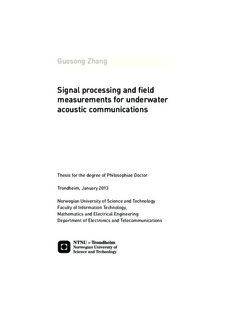| dc.description.abstract | The present dissertation presents new developments in the signal processing of receiver structures for high-rate underwater acoustic communications, and describes the field measurements that test the structures in real oceanic environments. The signalling methods of spectrally efficient spread spectrum are also investigated to achieve long range underwater acoustic communications. The digital signal processing is of significance in recovering distorted information, and compensating waveform distortions introduced by the underwater acoustic propagation. Underwater acoustic channels, particularly horizontal underwater channels, are characterized by extended multipath reflections, which are difficult to be predicted precisely, especially for typical underwater telemetry at high frequencies. Thus field experiments are of importance for the research in this dissertation.
Time delayed multipath arrivals result in intersymbol interference (ISI) for coherent communications, which causes errors in recovering distorted information, and hence a channel equalizer is required to remove the ISI. In recent years, passive-phase conjugation (PPC) processing has been researched for underwater acoustic communications, since its focusing property mitigates ISI with an enhanced output signal-to-noise ratio. After the focusing achieved by PPC processing, a simplified channel equalizer removes residual ISI, as ISI cannot be eliminated by the focusing with side lobes.
Residual ISI can be mitigated by time reversal focusing, which exploits spatial diversity in the water column to suppress side lobes of the focusing. High-rate time reversal communications have been achieved, where only one channel adaptive equalizer is used after the focusing. Compared with an adaptive multichannel equalizer, the complexity of time reversal focusing with a single channel equalizer is low. However, spatial gain obtained by time reversal focusing is impacted by time-variant interchannel correlations, which exist in a real oceanic environment, as time reversal focusing is conducted prior to the adaptive channel equalizer. The means obtaining a large spatial gain of reduced complexity is of significance in real applications, especially with a small number of receiving hydrophones.
A receiver structure of joint PPC with adaptive multichannel combining is proposed. PPC processing in each individual channel reduces ISI by the temporal focusing (pulse compression), and a subsequent multichannel equalizer of reduced complexity is used to remove residual ISI. Spatial gain is obtained by the adaptive multichannel combining, which exploits spatial diversity as well as removing ISI. As the combining is dependent on the output of the channel equalizer, this scheme is advantageous to make full use of spatial diversity. In practice, it is preferred that a small number of receiving hydrophones is used to reduce the complexity of instrumentation. In particular, results of experimental data processing have shown that this structure achieves superior performance over the time reversal receiver structure.
PPC processing requires knowledge of the channel, e.g. the channel impulse response, which is often characterized as time-varying and sparse, especially at high frequencies. In a time-varying channel, the temporal focusing degrades with time, and a block-based approach is applied to counter the channel variations. The channel is assumed constant within each block of short time duration, in which the channel response is estimated using detected symbols of the previous block. In a sparse channel, the matching pursuit (MP) algorithm can be used to exploit the channel sparsity for PPC processing. Compared with the conventional channel estimation method, e.g. the least squares (LS) method, the MP algorithm only obtains information of dominant arrivals. Without noise interference among dominant arrivals, the MP algorithm contributes improvement for communications using PPC processing.
In long range communications, a receiver structure has to counter acoustic attenuations together with waveform distortions. Hence spread spectrum techniques have advantages for communications at low input signal-to-noise ratios. During the work of this dissertation, two spread spectrum signalling schemes have been investigated with experimental demonstrations. Particularly, a spectrally efficient scheme using cyclic code shift keying has been proposed, and a time reversal receiver structure has been presented. This structure has obtained satisfactory performance in a field experiment over a range of 10 km. In this scenario, the time reversal structure takes advantage of spatial diversity to avoid deep fading occurring in each receiving channel, which usually happens in long range communications.
In the past 3 years of this dissertation, four major field measurements were carried out in Trondheim harbour. Those trials were designed to test underwater communications in different propagation conditions, e.g. in different months, as the environmental conditions changed over different seasons. In addition, the source locations were changed to test the communications in different experimental arrangements of source and receivers. For practical purposes of research, receiving waveforms were recorded for offline digital signal processing in the laboratory. Valuable experiences of instrumentation, data acquisition development, participation in instrument procurement, field experimental organization, etc., have been obtained during this dissertation. For the high-frequency (10-14 kHz) communications, it is infeasible to simulate the acoustic wave propagations in real ocean waveguide sufficiently accurately. Therefore, field experiments are of significant practical use for the research in underwater acoustic communications. As an important part in this dissertation, the major field experiments with instrumentation details are briefly introduced. Together with selected publications, selected results which have not previously been published are presented in this dissertation. | nb_NO |
